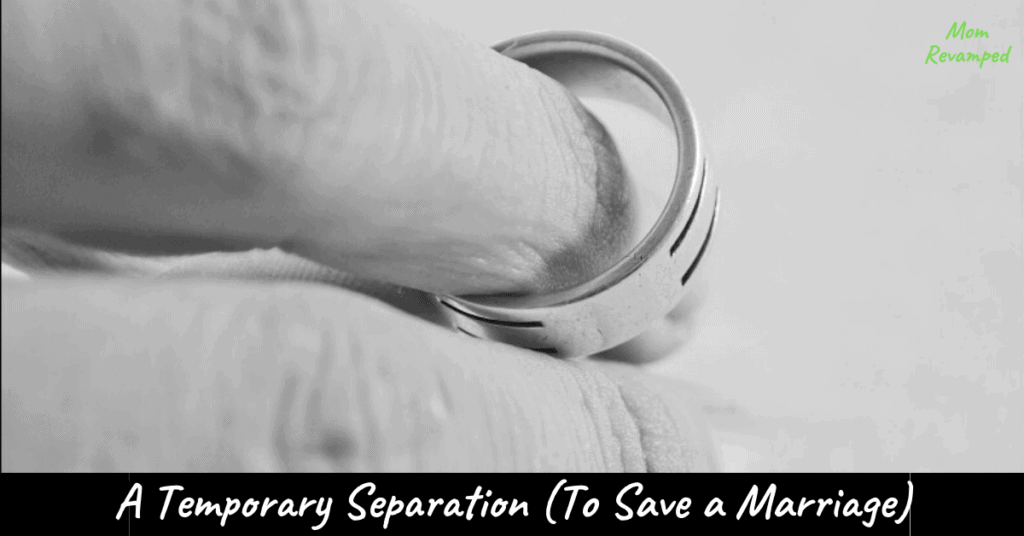This post may contain affiliate links. As an Amazon Associate I earn from qualifying purchases. If you click on the link and make a purchase I receive small commission (at no extra cost to you!), which helps fund the Mom Revamped Site.
Has your marriage reached the point where you or your partner, or maybe even both of you, have started thinking about separating or even divorcing?
Even thinking about ending your marriage can be heartbreaking and stressful. It’s hard to think that your relationship may be over. But maybe it doesn’t have to be. Maybe you’re just desperate to find a way to stop all the fighting.
Can separation save a marriage?
It seems like parting ways would make it hard to fix the problems in your marriage, but when the goal of the separation is to do just that, it is possible. Unlike a typical trial separation, the goal of the type of temporary separation I am referring to (often called a therapeutic separation or healing separation) is actually to save your marriage.
In my first blog post, I talked about how the changes I was making in my life were not just to be healthier, both physically and mentally, but happier too. I briefly mentioned how one of the areas I was focusing on was spending more time with my husband, since our 13-year marriage had been pushed to the back burner for far too long.
At that time, I thought all our marriage needed for us to be happier was us spending more time together to reconnect and to get in some regular date nights.
However, a couple of months ago it started to become apparent that our marriage was in far more trouble than I had realized.
After a month and a half of constant arguing, both of us couldn’t take it anymore. At that point, we started talking about separating. We were both so desperate to stop all the fighting we really couldn’t see another option.
Until I came across the concept of a temporary separation, with the goal of working on the marriage.
What Is A Temporary Separation?
A temporary separation is a temporary break from the stresses in the marriage.
It’s a break from the fighting and a break from the pressures that have been building in your relationship.
However, it is not an end to the relationship. While the couple lives apart, they are still technically in a relationship with each other, unlike a typical separation.
And unlike a typical separation, a temporary separation has a planned end date.
The Typical Trial Separation

The goal in a trial separation is often to allow each partner to experience what life would be like without the other.
So basically, it’s a chance to experience being single again.
For some people, the need for this experience may be to see if they could survive on their own. They may want to see what it would be like on their own financially. They may want to see if they could manage the household and parenting responsibilities on their own.
For others, the appeal of a trial separation may be the opportunity to date again. They may feel that dating someone new will help them to decide if their marriage is worth going back to, or if they could find happiness elsewhere.
Trial separations are rarely well planned. Often couples begin them without really understanding what they hope to gain from it.
Usually, the emphasis on a trial separation is just to get a break from each other, so they rarely involve planned time together or regular communication with each other.
Many trial separations become permanent and ultimately result in divorce.
A trial separation is a type of temporary separation. But it is not the only type and is often not the best choice if you want to save your marriage.
Types of Temporary Separations
If your goal in separating from your spouse is to reconcile than the type of temporary separation you need is one where you are working on your marriage, not testing the waters to see what it’s like to be single.
There are many different names for temporary separations that are meant to work on the marriage. What they all have in common is that unlike trial separations, they are a working separation.
The Therapeutic Separation
The term therapeutic separation seems to be the most popular name used to describe these types of temporary separations. The goal of the therapeutic separation is to provide relief from the conflict in the marriage while working on individual progress.
The Healing Separation
The term healing separation originated from the book Rebuilding: When Your Relationship Ends by Bruce Fisher. The goal of the healing separation is to work on personal growth, both for your own needs and the needs of your relationship. Spending quality time together to work on rebuilding your marriage is also an essential component.
The Controlled separation
The term “Controlled Separation” comes from the book Should I Stay Or Go?: How Controlled Separation (CS) Can Save Your Marriage, by Lee Raffel. This type of temporary separation is essentially the same as the healing separation, but the book has strict guidelines that are followed and a contract that the couple must agree on, often with the help of a counselor.
Some other names people have put on these working separations are
- enhancement separation
- structured separation
- planned separation
The concepts behind all of them are the same. You get a break from the fighting and conflict in the marriage while taking the time to work on yourself and to work on rebuilding your relationship.
What title you put on it is up to you.
I personally like the term healing separation best, so that is what I am calling my separation. However, since this concept isn’t very well known when we told our family and friends my husband and I just simply said we were temporarily separating while we worked on our marriage
The In-house Separation
There is one other type of temporary separation that is worth mentioning.
The “In-house” separation.
For some couples having one spouse physically move out just isn’t possible, often for financial reasons. Or they may simply not want to put their kids through the process of having one parent leave.
Still, even with an in-house separation, one spouse needs to move out of the marital bedroom to another location in the home. This may mean just sleeping in the guest room or on the couch. Or maybe moving into a finished basement or even a granny flat in the same house.
Like a regular temporary separation, this also involves the couple essentially living separate lives, just like they would if they were separated physically.
While the in-house separation may work for some people, for most people more physical space is necessary to get the full benefits of the temporary separation.
How Can a Separation Save a Marriage?
If you’re still reading this then your goal for separating, or considering a separation, is probably to save your marriage.
So how can a temporary separation do that?
- It can ease up the fighting. I’m not saying there will be no fighting once you part ways, but it will at least stop adding to some of the tension in your marriage that’s caused by silly arguments about things like who’s turn it is to do the dishes.
- It gives you time and space to cool off a bit and realize your true feelings. With this extra alone time, you may finally be able to process all those emotions that come up during the fighting and figure out how you really feel about your marriage and your spouse.
- You can rebuild a connection with your spouse. Since an essential component of this type of temporary separation is to spend some quality time together, you will be able to work on repairing the emotional connection. Taking this time to really get to know your spouse again can give you an opportunity to see what you really like about them and see all the things you miss while you are apart.
- It will give you time to work on yourself. Maybe life has just gotten so busy you don’t even know who you are anymore. This separation will give you time to figure out what you need to do to live a happier life and what personal growth you need to work on. Often couples find that individual counselling can help them with this process.
- You will have time to work on the changes you need to make for your marriage. Maybe you have been struggling with some personal issues that have interfered in your ability to bring your best to your marriage. Maybe you just need to learn how to be a better wife/husband. You may find reading marriage books or listening to them together on Audible (the two I recommend are The Seven Principles for Making Marriage Work, by John Gottman and The 5 Love Languages by Gary Chapman), or listening to podcasts on marriage ( My favorites are The One Extraordinary Marriage or The Save the Marriage Podcast ).
- You can work on the issues in your marriage. For most couples, this will mean going to couples counselling. It may also be helpful to read books and articles to learn how to better communicate with each other and how to work through typical marital conflict.
The Importance of a Separation Plan

A big difference between a typical trial separation and one that is meant to actually save your marriage is having a plan.
Without the plan, you’re really just separating.
You and your spouse need to be on the same page for this to work. You both need to know what is expected from each of you. In order for you to work on the issues that you need to be working on, you first need to be able to agree on what those issues are.
In the book “Should I Stay Or Go?: How Controlled Separation (CS) Can Save Your Marriage”, Lee Raffel refers to this plan as a contract.My
My husband and I both found that calling it a “contract” just didn’t feel right. This was our marriage, not a business deal. Plus, a contract typically isn’t flexible, and as we wrote ours out we realized that there were things that would likely change over time. Instead, we referred to ours as a separation plan.
Components of The Separation Plan
What you include in your temporary separation plan is really up to you. This is an individualized plan that is meant to meet your needs, your spouse’s needs, the needs in your marriage and the needs in your family.
Here are some of the main component that you may want to include
- Living arrangements
- Finances
- Custody (if there are children)
- A timeline
- Legal plans
- Confidentiality
- Dating others
- Goals
- Communication
- Time together
- Sex
- Working on the marriage
- Therapy or counselling
- Personal growth
- Renegotiations
See this post for more information about things to consider for your separation plan.
Do You Need A Formal Separation Agreement Too?
Many of the things you include in your separation plan will cover anything that would need to be included in a legal separation agreement, like finances, who’s moving out, and who the kids will live with.
However, there may still be reasons that you will need to make a formal separation agreement too.
For example, if you live in Canada and plan on notifying the government of your change in marital status so you’re child tax credit, trillium benefit
or GST/HST amounts can be adjusted, you will need a legal separation agreement to prove you are now separated (note, this can not be done until you have been separated for 90 days). A separation agreement may also be needed when you file your income taxes if you will be filing separately.
You will need to look at what is needed where you live to determine if a formal agreement will be necessary. If you do decide you need one, you can easily do it yourself using an online template.
Another reason to do a formal separation agreement is so that you have things like child support, parenting time/custody, and temporary possession of any assets in a formal agreement just in case the separation does become permanent. While you will still need to go through the process of finalizing all of those in a divorce, having a temporary agreement to start is helpful. Since this agreement will be written while you’re still on good terms, it is more likely that you will both be able to focus on doing what is best for your kids too.
Is Your Marriage Worth Saving?

Now that we have covered what a temporary separation is and how it can save your marriage, let’s talk about why you should try to save your marriage.
In the midst of all the fighting, it may be hard to see a reason to keep trying.
If the emotional connection between you and your spouse has faded you may not even know if you still want to be with her/him. If you have a lot of issues that weren’t resolved in the past, you or your spouse may be holding onto a lot of resentment for the other.
But when you actually make the effort, these are all things that can be fixed.
Personally, I think the problem with a lot of marriages, and the reason our divorce rates are so high is that people think marriage should be easy.
It’s not.
Marriage is hard.
Marriages require work.
Marriages take effort.
So, before you give up and decide that your marriage isn’t worth saving ask yourself, “have I really tried? Have I really given this marriage the effort and put in the work that is needed?”.
Maybe you feel like you have made the effort and you have done the work. Maybe you feel like your spouse is the one who hasn’t been trying. Could this temporary separation be the motivation she/he needs to finally start trying?
You may both put in all the effort and work and still find that your relationship just doesn’t work. Or maybe once you are both making the effort that is needed you will finally have the marriage you had hoped for.
It’s up to you to decide if it’s worth giving it one more try.
Now the question you’ve probably been wondering through this whole post.
Does a temporary separation actually work?
Can separation save a marriage?
Unfortunately, I couldn’t find much information about how successful these temporary separations usually are. Since this concept really isn’t well known, there just isn’t much data on the effectiveness of it.
All I can tell you is that I think it’s worth a shot.
If you want to see how it works out for me follow me on Facebook for updates and to see what other marriage saving advice I find (and how I will work on my own personal growth during my separation).
And don’t forget to read my post about how to write a healing separation agreement.
Have you ever heard of anyone doing a therapeutic separation? Do have any experience with a separation saving a marriage? I would love to hear stories from other people who have done this, so please share your experiences.

